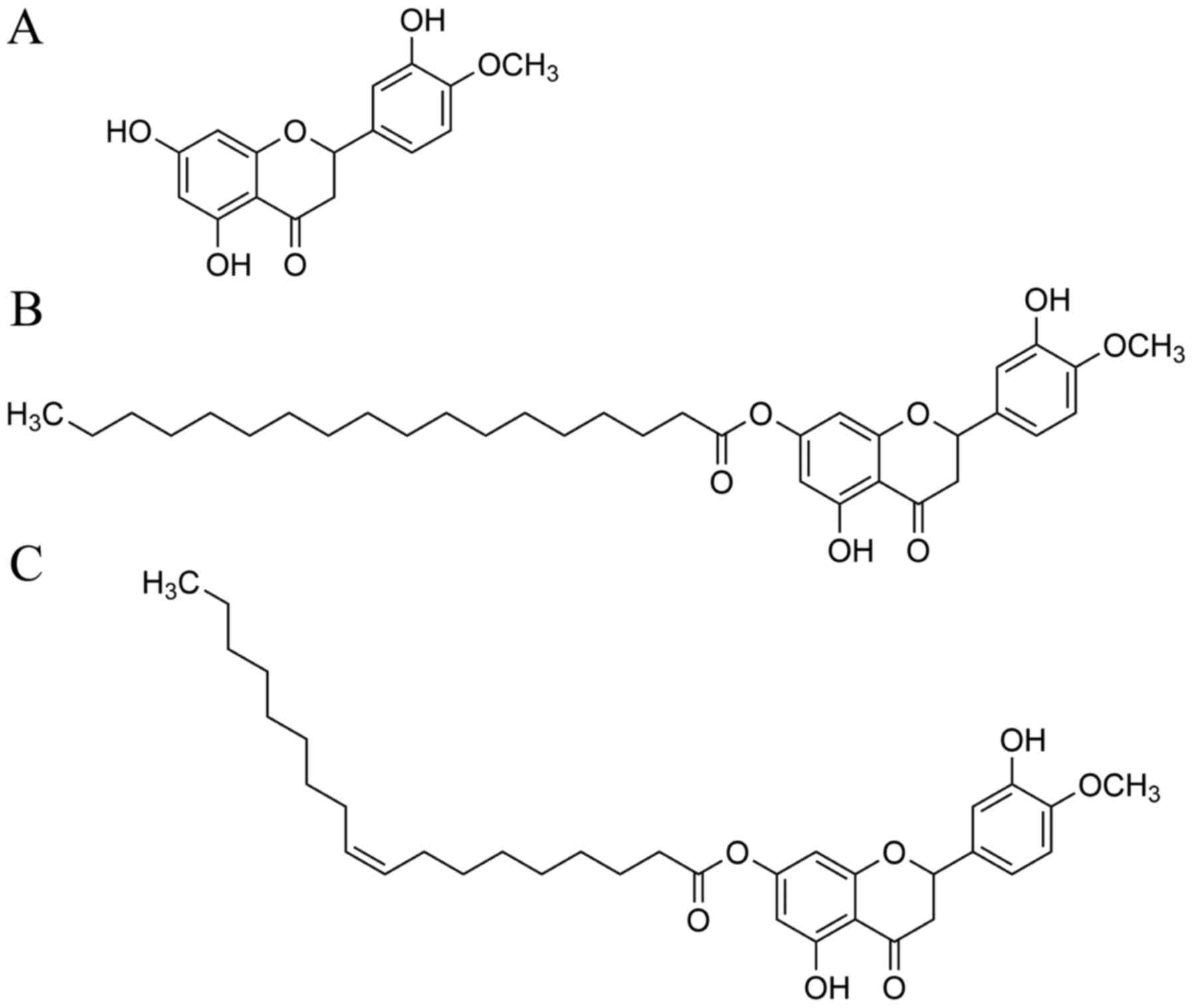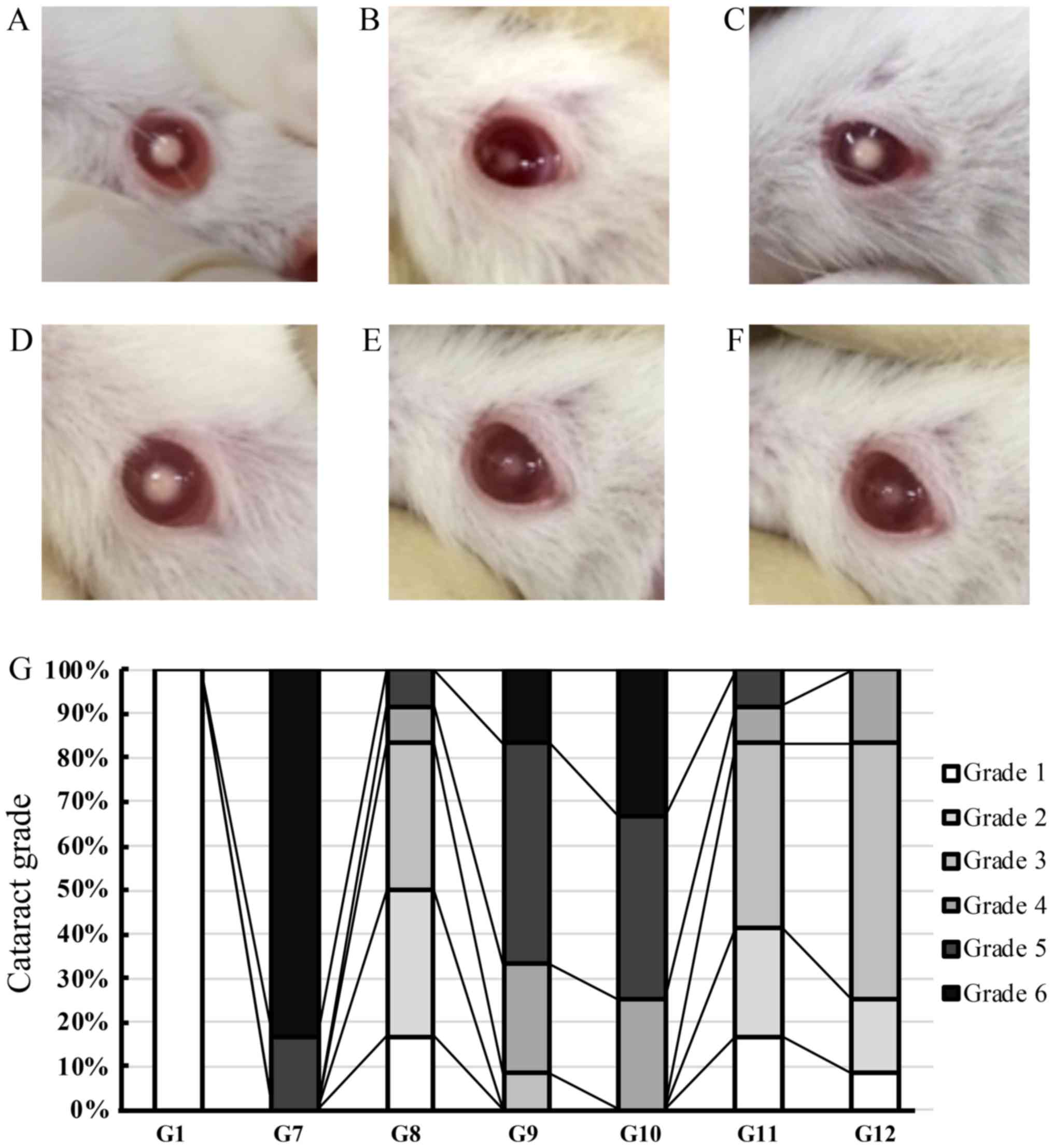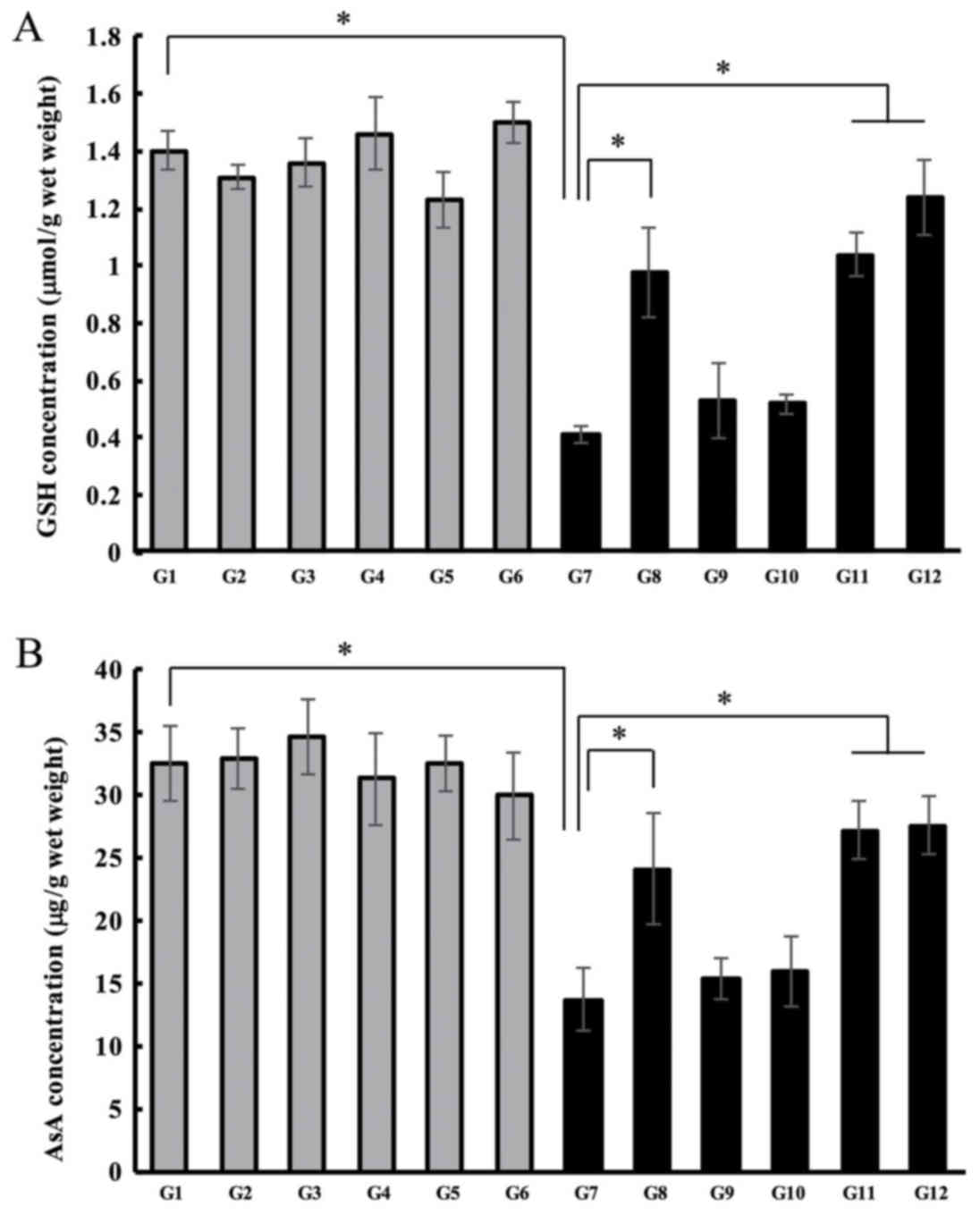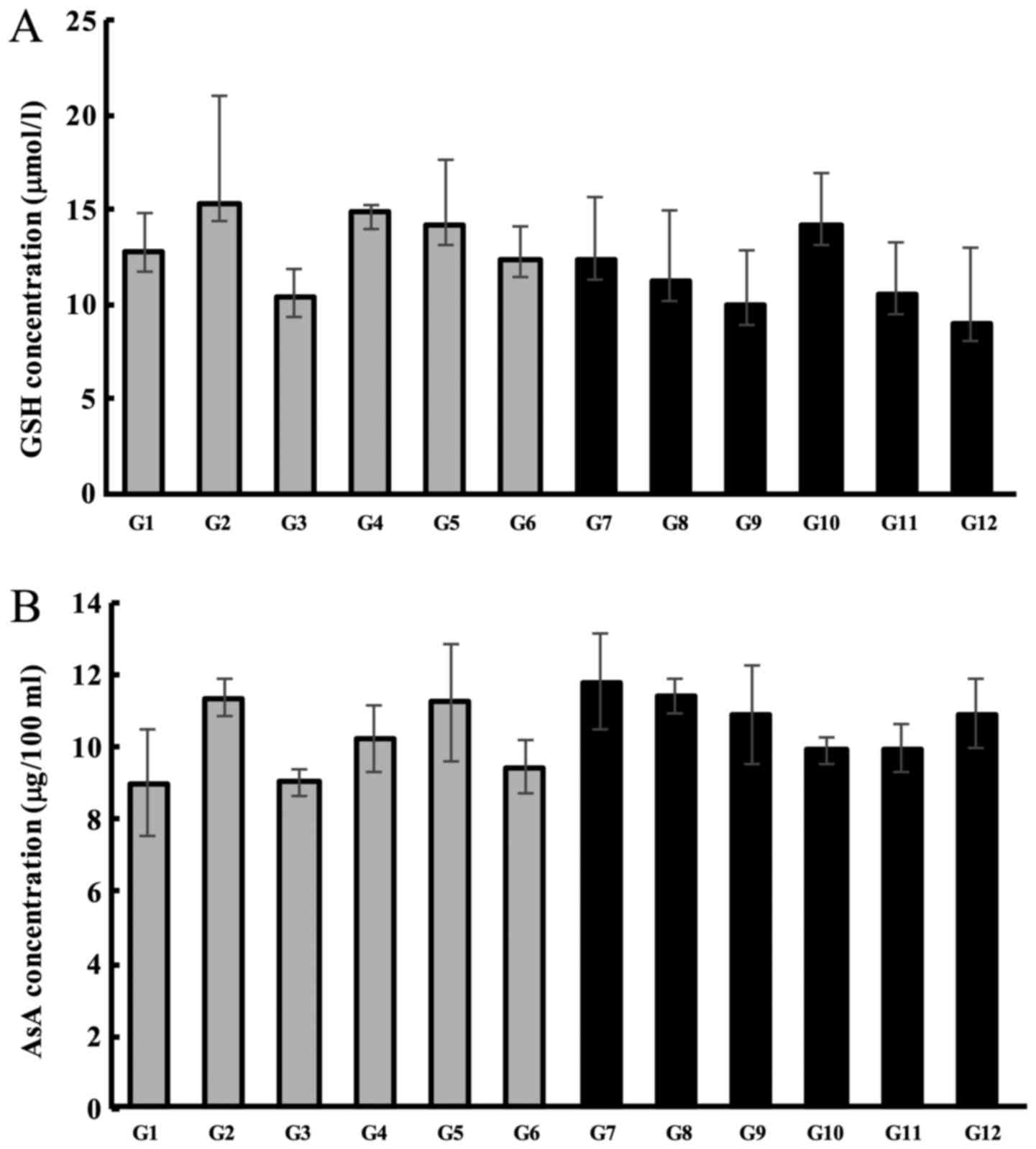|
1
|
Khairallah M, Kahloun R, Bourne R, Limburg
H, Flaxman SR, Jonas JB, Keeffe J, Leasher J, Naidoo K, Pesudovs K,
et al: Number of people blind or visually impaired by cataract
worldwide and in world regions, 1990 to 2010. Invest Ophthalmol Vis
Sci. 56:6762–6769. 2015. View Article : Google Scholar : PubMed/NCBI
|
|
2
|
Liu YC, Wilkins M, Kim T, Malyugin B and
Mehta JS: Cataract. Lancet. 390:600–612. 2017. View Article : Google Scholar : PubMed/NCBI
|
|
3
|
Bergamini CM, Gambetti S, Dondi A and
Cervellati C: Oxygen, reactive oxygen species and tissue damage.
Curr Pharm Des. 10:1611–1626. 2004. View Article : Google Scholar : PubMed/NCBI
|
|
4
|
Pau H, Graf P and Sies H: Glutathione
levels in human lens: Regional distribution in different forms of
cataract. Exp Eye Res. 50:17–20. 1990. View Article : Google Scholar : PubMed/NCBI
|
|
5
|
Kamei A: Glutathione levels of the human
crystalline lens in aging and its antioxidant effect against the
oxidation of lens proteins. Biol Pharm Bull. 16:870–875. 1993.
View Article : Google Scholar : PubMed/NCBI
|
|
6
|
Nakazawa Y, Oka M, Bando M, Inoue T and
Takehana M: The role of ascorbic acid transporter in the lens of
streptozotocin-induced diabetic rat. Biomed Prev Nutr. 1:43–48.
2011. View Article : Google Scholar
|
|
7
|
Grey AC, Demarais NJ, West BJ and
Donaldson PJ: A quantitative map of glutathione in the aging human
lens. Int J Mass Spectrom. (In press).
|
|
8
|
Nakazawa Y, Oka M, Bando M and Takehana M:
Hesperetin prevents selenite-induced cataract in rats. Mol Vis.
21:804–810. 2015.PubMed/NCBI
|
|
9
|
Nakazawa Y, Oka M, Tamura H and Takehana
M: Effect of hesperetin on chaperone activity in selenite-induced
cataract. Open Med (Wars). 11:183–189. 2016.PubMed/NCBI
|
|
10
|
Jeong TS, Kim EE, Lee CH, Oh JH, Moon SS,
Lee WS, Oh GT, Lee S and Bok SH: Hypocholesterolemic activity of
hesperetin derivatives. Bioorg Med Chem Lett. 13:2663–2665. 2003.
View Article : Google Scholar : PubMed/NCBI
|
|
11
|
Ishimori N, Oguchi J, Nakazawa Y, Kobata
K, Funakoshi-Tago M and Tamura H: Roasting enhances the
anti-cataract effect of coffee beans: Ameliorating Selenite-induced
cataracts in rats. Curr Eye Res. 42:864–870. 2017. View Article : Google Scholar : PubMed/NCBI
|
|
12
|
Sedlak J and Lindsay RH: Estimation of
total, protein-bound and nonprotein sulfhydryl groups in tissue
with Ellman's reagent. Anal Biochem. 25:192–205. 1968. View Article : Google Scholar : PubMed/NCBI
|
|
13
|
Nakazawa Y, Nagai N, Ishimori N, Oguchi J
and Tamura H: Administration of antioxidant compounds affects the
lens chaperone activity and prevents the onset of cataracts. Biomed
Pharmacother. 95:137–143. 2017. View Article : Google Scholar : PubMed/NCBI
|
|
14
|
Manikandan R, Thiagarajan R, Beulaja S,
Sudhandiran G and Arumugam M: Effect of curcumin on
selenite-induced cataractogenesis in Wistar rat pups. Curr Eye Res.
35:122–129. 2010. View Article : Google Scholar : PubMed/NCBI
|
|
15
|
Aydemir O, Güler M, Kaya MK, Deniz N and
Üstündağ B: Protective effects of ebselen on
sodium-selenite-induced experimental cataract in rats. J Cataract
Refract Surg. 38:2160–2166. 2012. View Article : Google Scholar : PubMed/NCBI
|
|
16
|
Hwang SL and Yen GC: Effect of hesperetin
against oxidative stress via ER- and TrkA-mediated actions in PC12
cells. J Agric Food Chem. 59:5779–5785. 2011. View Article : Google Scholar : PubMed/NCBI
|
|
17
|
St-Pierre J, Drori S, Uldry M, Silvaggi
JM, Rhee J, Jäger S, Handschin C, Zheng K, Lin J, Yang W, et al:
Suppression of reactive oxygen species and neurodegeneration by the
PGC-1 transcriptional coactivators. Cell. 127:397–408. 2006.
View Article : Google Scholar : PubMed/NCBI
|
|
18
|
Lu X, Kambe F, Cao X, Kozaki Y, Kaji T,
Ishii T and Seo H: 3beta-Hydroxysteroid-delta24 reductase is a
hydrogen peroxide scavenger, protecting cells from oxidative
stress-induced apoptosis. Endocrinology. 149:3267–3273. 2008.
View Article : Google Scholar : PubMed/NCBI
|
|
19
|
Effros RM and Mason GR: Measurements of
pulmonary epithelial permeability in vivo. Am Rev Respir Dis.
127:S59–S65. 1983.PubMed/NCBI
|
|
20
|
Schneeberger EE: Airway and alveolar
epithelia cell junctionsThe lung: Scientific foundations. Crystal
RG, West JB, Barnes PJ, Cherniack NS and Weibel ER: Raven Press;
New York: pp. 205–214. 1991
|
|
21
|
Ohtsuki K, Abe A, Mitsuzuwi H, Kondo M,
Uemura K, Iwasaki Y and Kondo Y: Effects of long-term
administration of hesperidin and glucosyl hesperidin to
spontaneously hypertensive rats. J Nutr Sci Vitaminol (Tokyo).
48:420–422. 2002. View Article : Google Scholar : PubMed/NCBI
|
|
22
|
Miwa Y, Mitsuzumi H, Sunayama T, Yamada M,
Okada K, Kubota M, Chaen H, Mishima Y and Kibata M: Glucosyl
hesperidin lowers serum triglyceride level in hypertriglyceridemic
subjects through the improvement of very low-density lipoprotein
metabolic abnormality. J Nutr Sci Vitaminol (Tokyo). 51:460–470.
2005. View Article : Google Scholar : PubMed/NCBI
|
|
23
|
Parhiz H, Roohbakhsh A, Soltani F, Rezaee
R and Iranshahi M: Antioxidant and anti-inflammatory properties of
the citrus flavonoids hesperidin and hesperetin: An updated review
of their molecular mechanisms and experimental models. Phytother
Res. 29:323–331. 2015. View
Article : Google Scholar : PubMed/NCBI
|














